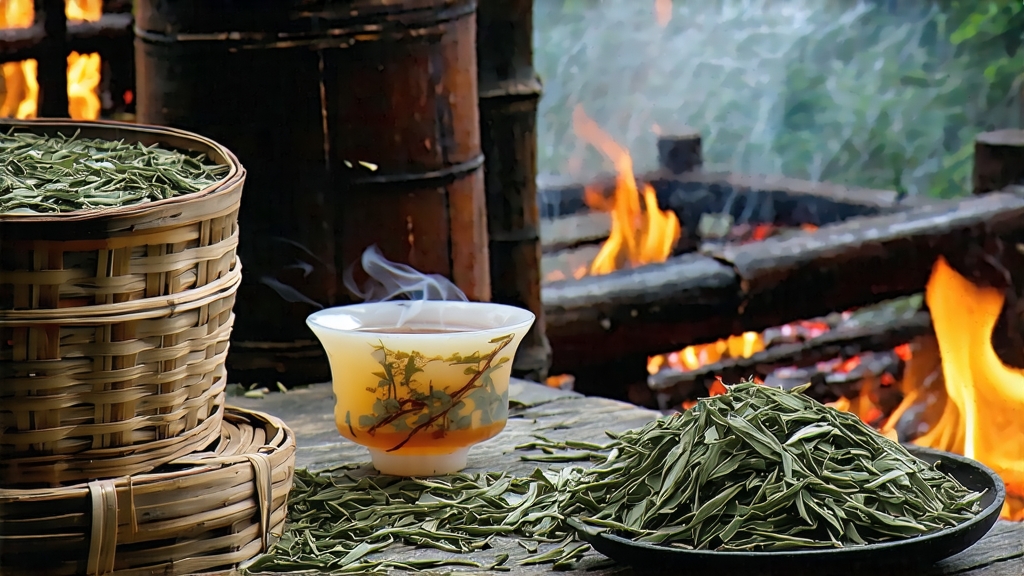
Long before English breakfast blends filled porcelain pots in London drawing rooms, a small village in the Wuyi Mountains of northern Fujian produced a tea so radically different from the green teas of the day that European merchants coined a new word for it: “black.” That village was Tongmu Guan, and the tea was Lapsang Souchong—today celebrated as the forebear of every black tea on earth. To understand Lapsang Souchong is to witness the moment when Chinese tea craft stepped from the fragrance of spring buds into the dark, smouldering aroma of winter campfires, creating a liquor that still tastes like history itself.
History: From Ming-Era Accident to Global Sensation
Local legend places the birth of Lapsang Souchong late in the Ming dynasty, around 1604. An army unit, passing through Tongmu Guan during harvest season, commandeered the tea sheds for barracks. When the farmers returned, the leaves—already withered—were too soft to process in the usual green-tea fashion. In desperation they dried the leaf over available pine fires to halt oxidation, packed it quickly, and sent it down the Nine-Dragon Gorge to the port of Xingcun. Dutch buyers tasted the result, found its smoky sweetness unlike anything in Europe, and re-ordered every chest. By the early Qing, “Bohea Souchong” (the corruption of “Wuyi” and the term for the fifth leaf grade) was auctioned in Amsterdam and London at prices higher than silver. When the British later planted tea in India and Sri Lanka, they used Lapsang Souchong as the genetic and stylistic template for their own black teas, cementing its status as the archetype.
Terroir: Why Only Tongmu Guan Can Birth the Original
The Wuyi range is a UNESCO dual heritage site where subtropical mists rise from the Jiuqu (Nine-Bend) River, wrapping cliffs of volcanic tuff. At 600–1,200 m elevation, daytime heat and cool nights lengthen the growing cycle, concentrating amino acids and sugars. Critically, the gorge traps resinous pine (Pinus massoniana) and cedar smoke; the same trees that fuel the drying fires perfume the mountain air year-round. Chinese law now restricts the use of “Zheng Shan Xiao Zhong” (the protected geographical indication) to leaf picked within Tongmu Guan’s 50 km² core zone; any tea smoked elsewhere must be labeled simply “smoked black tea.” Thus, authentic Lapsang Souchong is inseparable from its landscape.
Leaf Grades & Styles
- Zheng Shan Xiao Zhong (Original Souchong): made only from small-leaf tea bushes growing wild on cliff terraces; lightly withered, cold-smoked with young pine embers, then charcoal-baked. The liquor is amber-bright, the smoke subtle—more incense than barbecue.
- Traditional Lapsang Souchong: larger-leaf material from surrounding townships; withered over hot pine fires, giving a pronounced tarry note and a thicker body.
- Unsmoked Souchong (Wu Zhong): a modern response to market demand for sweeter, honey-like cups; processed like a standard black tea but still grown in Tongmu Guan, yielding dried-longan and lychee aromas.
- Special Finishes: some lots are aged in bamboo tubes or clay jars for five-plus years, softening smoke into camphor and dark chocolate; others are blended with alpine flowers for perfumed variants.
Craft: Turning Green Leaf into Smoked Memory
Harvest begins around Qingming (early April) when two leaves and a bud still wear their spring down. The pluck is spread 3 cm deep on bamboo trays inside wooden sheds; mountain breezes reduce moisture to 60 % over 8–10 hours. Next comes rolling: 45 minutes of machine-assisted bruising that ruptures cells and launches oxidation. The leaf is then piled in pine-wood boxes; temperature climbs to 28 °C, turning the leaf from jade to copper in two hours. The critical smoking follows. A shallow pit is dug in the shed floor; pinewood slabs are set alight, then smothered with damp sawdust to create a cool, aromatic smoke (28–32 °C). Trays of oxidised leaf are stacked 1.5 m above the